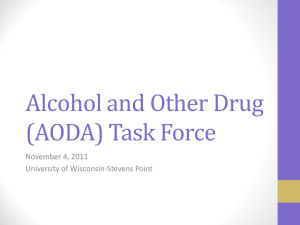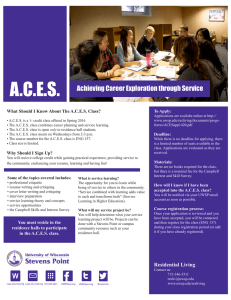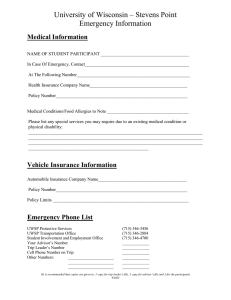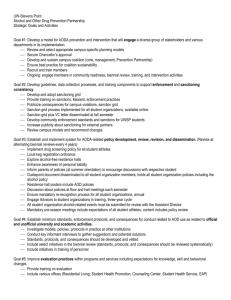University of Wisconsin—Stevens Point Period under review 2010-2011
advertisement
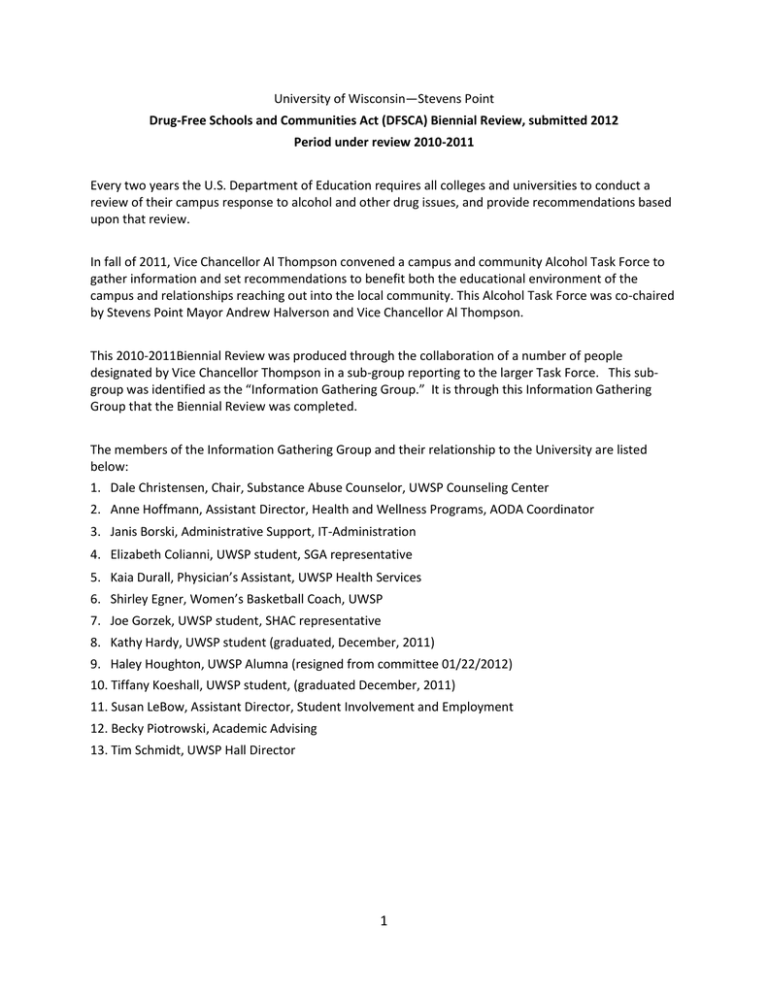
University of Wisconsin—Stevens Point Drug-Free Schools and Communities Act (DFSCA) Biennial Review, submitted 2012 Period under review 2010-2011 Every two years the U.S. Department of Education requires all colleges and universities to conduct a review of their campus response to alcohol and other drug issues, and provide recommendations based upon that review. In fall of 2011, Vice Chancellor Al Thompson convened a campus and community Alcohol Task Force to gather information and set recommendations to benefit both the educational environment of the campus and relationships reaching out into the local community. This Alcohol Task Force was co-chaired by Stevens Point Mayor Andrew Halverson and Vice Chancellor Al Thompson. This 2010-2011Biennial Review was produced through the collaboration of a number of people designated by Vice Chancellor Thompson in a sub-group reporting to the larger Task Force. This subgroup was identified as the “Information Gathering Group.” It is through this Information Gathering Group that the Biennial Review was completed. The members of the Information Gathering Group and their relationship to the University are listed below: 1. Dale Christensen, Chair, Substance Abuse Counselor, UWSP Counseling Center 2. Anne Hoffmann, Assistant Director, Health and Wellness Programs, AODA Coordinator 3. Janis Borski, Administrative Support, IT-Administration 4. Elizabeth Colianni, UWSP student, SGA representative 5. Kaia Durall, Physician’s Assistant, UWSP Health Services 6. Shirley Egner, Women’s Basketball Coach, UWSP 7. Joe Gorzek, UWSP student, SHAC representative 8. Kathy Hardy, UWSP student (graduated, December, 2011) 9. Haley Houghton, UWSP Alumna (resigned from committee 01/22/2012) 10. Tiffany Koeshall, UWSP student, (graduated December, 2011) 11. Susan LeBow, Assistant Director, Student Involvement and Employment 12. Becky Piotrowski, Academic Advising 13. Tim Schmidt, UWSP Hall Director 1 Review Timeline and Process The information Gathering Group performed the following tasks during the 2011-2012 academic year in support of the biennial review for the period 2012-2011. December 2011— Introductory meeting, background information, essential web tools, reviewed Part 86 requirements February 2012— Identification of information to gather, discussed departments to contact, made assignments of departmental contacts to committee members, conducted SharePoint training Content gathered included AODA-related programs and services, policies and sanctions Members gathered information from myriad departments concurrently and posted information to Sharepoint using a common template; information gathered using phone or in-person interviews Members reviewed content individually and as a group in meetings March 2012 Continued discussion of posted content Began to identify themes for improvement from posted content in terms of programs, services, policies and sanctions Formulated process for making recommendations April 2012 Early themes identified from posted content, formulated recommendations, revised, and finalized Report drafted by chair May 2012 Present overview of report, focus on recommendations, to Task Force 2 The following departments were invited to answer questions regarding AODA-related programs, services, polices, and sanctions during the biennial review process. Comments from departments were distilled by committee members and embedded in individual templates for review by committee members. Academic Advising/Academic Programs International Students and Scholars Admissions University Centers Alumni Office Athletics Child Learning and Care Center Continuing Education Counseling Center CWES/Treehaven Dining Financial Aid Personnel/Classified and Unclassified Diversity and College Access Orientation, New Student Protective Services Residence Hall Association Student Government Association Rights and Responsibilities Student Involvement and Employment Student Affairs, Division of Student Health Promotion Student Health Services International Programs, Study Abroad 3 Part 86 In responding to the Biennial Review, Part 86 Check List, the Information Gathering Group applied a strong emphasis to the standard of “can the University provide reasonable assurance that information has indeed been provided to the groups identified?” As can be seen in the responses given below the answer is usually “no, reasonable assurance cannot be demonstrated that information has been delivered.” As noted in a previous Biennial Review, it may be that information has been provided in some instances. However, with the standard of reasonable assurance, the responses given this year are often “no” due to departmental inconsistencies, varied campus policies, and lack of after-the-fact documentation. The more stringent standard is an ethical position taken to assure communications with students, faculty, and staff. Given the seriousness of consequences caused by alcohol and other drug abuse on college campuses this is the most responsible position of the University. Part 86 Compliance Checklist Part 86, Drug-Free Schools and Campuses Regulations Compliance Checklist Does the institution maintain a copy of its drug prevention program? Yes If yes, where is it located? Student Health Promotion Office Does the institution provide annually to each employee and each student, who is taking one or more classes for any type of academic credit except for continuing education units, written materials that adequately describe and contain the following? a. Standards of conduct that prohibit unlawful possession, use, or distribution of illicit drugs and alcohol on its property or as a part of its activities Students: No Staff and Faculty: No b. A description of the health risks associated with the use of illicit drugs and the abuse of alcohol Students: No Staff and Faculty: No c. A description of applicable legal sanctions under local, state, or federal law Students: No Staff and Faculty: No d. A description of applicable counseling, treatment, or rehabilitation or re-entry programs Students: No Staff and Faculty: No e. A clear statement of the disciplinary sanctions the institution will impose on students and employees, and a description of those sanctions Students: No Staff and Faculty: No Are the above materials distributed to students in one of the following ways? a. Mailed to each student (separately or included in another mailing) No b. Through campus post offices boxes No c. Class schedules which are mailed to each student No d. During freshman orientation No 4 e. During new student orientation No f. In another manner (describe) Residence hall policy, University Handbook, Individual Dept Does the means of distribution provide reasonable assurance that each student receives the materials annually? No Does the institution's distribution plan make provisions for providing these materials to students who enroll at some date after the initial distribution? No Are the above materials distributed to staff and faculty in one of the following ways? a. Mailed Staff: No Faculty: No b. Through campus post office boxes Staff: No Faculty: No c. During new employee orientation Staff: No Faculty: No Does the means of distribution provide reasonable assurance that each staff and faculty member receives the materials annually? Staff: No Faculty: No Does the institution's distribution plan make provisions for providing these materials to staff and faculty who are hired after the initial distribution? Staff: No Faculty: No In what ways does the institution conduct biennial reviews of its drug prevention program to determine effectiveness, implement necessary changes, and ensure that disciplinary sanctions are enforced? a. Conduct student alcohol and drug use survey a. Yes b. Conduct opinion survey of its students, staff, and faculty i. Students: No Staff and Faculty: No c. Evaluate comments obtained from a suggestion box i. Students: No Staff and Faculty: No d. Conduct focus groups i. Students: No Staff and Faculty: No e. Conduct intercept interviews i. Students: No Staff and Faculty: No f. Assess effectiveness of documented mandatory drug treatment referrals for students and employees Students: No Staff and Faculty: No Assess effectiveness of documented mandatory drug treatment referrals for students and employees Students: No Staff and Faculty: No Who is responsible for conducting these biennial reviews? Vice Chancellor for Student Affairs, delegated to AODA Coordinator If requested, has the institution made available, to the Secretary and the public, a copy of each requested item in the drug prevention program and the results of the biennial review? Yes Where is the biennial review documentation located? Anne Hoffmann, Assistant Director, Health and Wellness Programs University Centers, 715-346-4290, ahoffman@uwsp.edu. 5 Biennial Review Recommendations—Review Period 2010 - 2011 Recommendation #1 Develop a model for AODA prevention and intervention that will engage a diverse group of stakeholders (students, faculty, staff, and community) and a variety of departments (academic affairs, student life, athletics, and personnel, as examples) in its implementation. Recommendation #2 Establish minimum standards, enforcement protocols, and consequences for conduct related to AOD use as related to official and unofficial university and academic activities. -Standards, protocols and consequences should be reviewed systematically. -Leaders should be assigned to conduct respective reviews. Recommendation #3 Improve evaluation practices for prevention and intervention programs and services in terms of knowledge, skill and behavioral changes. -Evaluation should also include mandated referrals. -Evaluation should also include informal follow-up. Recommendation #4 Implement best practices in prevention and intervention as advanced by the National Institute of Alcohol Abuse and Alcoholism, the Higher Education Center, and/or related research findings. -Explore parental education and communication as a beneficial strategy for prevention or intervention Recommendation #5 Establish communications plan and curriculum to share AODA-related data, prevention strategies, resources, and alcohol-free options with faculty, staff, and student employees. -Alcohol-Wise program made available to campus for review Recommendation #6 Develop guidelines, process and training modules to support consistency and comprehensive data collection with regard to AODA-related sanctioning. -Provide broader access to Maxient (database program) for recording and reporting 6

